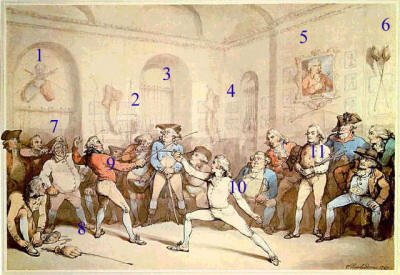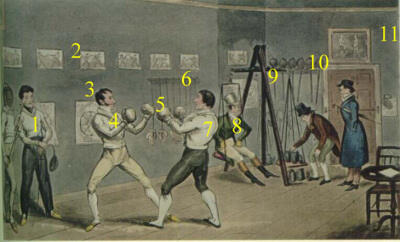
"I shall conquer this" - Rowlandson's coloured etching of Harry Angelo's Salle d'Armes, 1787
By Tony Wolf

In 1785 fencing master Harry Angelo left his father Domenico's School of Arms in Carlisle House and established his own academy at the Opera House in London's fashionable Haymarket district. Here he conducted lessons, both in his father's traditional style of foil fencing, and also in single-stick play, for which he had a particular fondness. His students included many young aristocrats, as well as actors and other artists. The Opera House School flourished until 1789, when it was destroyed by fire.
1 -This alcove contains a foil mask, crossed foils or smallswords, and what appear to be red and blue plastrons.
2 - Several foils are suspended on this wall. The object that looks like an arm hanging from a cushion is probably a padded sleeve and glove for use in singlestick practice.
3 - An assortment of foils hanging in a rack.
4 - This corner and alcove contain more foils and what appears to be a jacket or cloak. The pictures are probably framed prints from Domenico Angelo's Ecole des Armes, first published in 1763.
5 - This portrait is of the famed swordsman, the Chevalier de St. George, as painted by Mather Brown. It was one of Harry Angelo's most prized possessions, and the only object he managed to rescue from the fire. The Chevalier apparently also donated his fencing slippers and foils to Angelo's school, and these may be seen arranged beneath the portrait.
6 - A set of singlesticks, wooden practice weapons used in sabre and cutlass training.
7 - A fencer is assisted in having his mask tied on. The fashion of wearing fencing masks was still relatively new, and many traditionalists scorned them as indicative either of fear, or of a lack of respect for their opponent's control.
8 - A fencer either prepares for or recovers from a bout, his foil and padded glove on the floor in front of him. The curious object resembling a turtle's shell to his left probably represents a foil mask.
9 - The identity of this fencer is unknown, although Gosselin's contemporary replica of this etching is captioned Grand Assaut dans la Salle d'Armes d'Angelo par la Chevalier d'Eon et le Sergent Leger (Grand Bout in Angelo's School of Arms by the Chevalier d'Eon and Sergeant Leger). British fencing historian J.D. Aylward doubts this attribution:
"The youthful figure may perhaps have been Leger, if he were the son of that Leger, Maitre d'Armes to the Regiment de Bourbon, who was waylaid and assassinated in the rue du Pelican, behind the Palais Royal, in 1773. But it does not seem that either figure is intended for d'Eon. One is too young; the other too portly and too awkward."
10 - Aylward believes that this figure is actually that of Harry Angelo.
11 - This is probably Domenico Angelo, bearing a critical eye and standing by with spare foils should the need arise.
Among the spectators are figures said to be those of the Marquis of Buckingham, Charles James Fox, Dennis O'Kelly and the French Maitre d'Armes, Lebrun.

After the fire at the Opera House, Harry Angelo went into partnership
with pugilist and boxing teacher John "Gentleman" Jackson and opened a
School of Arms at No. 13, Bond Street, London. This picture is part of
a series of illustrations produced for Pierce Egan's popular serialised
novel of the early 1820s, "Life
in London", and portrays Egan's characters "Corinthian Tom" and Jerry
Hawthorn visiting the Bond Street school.
1 - A pair of foil fencers watch the pugilists sparring. Although Angelo and Jackson shared the school premises, teaching there on alternate days, it seems that paid members could also attend on "off-days".
2 - A set of framed pictures, probably prints of the forty-seven plates used in Ecole des Armes.
3 - A sabre or cutlass chart. Between 1794 and 1796 Harry Angelo was commissioned to develop a system of instruction for the City of London Light Horse Volunteers, despite having little practical experience with either the light or heavy cavalry sabre. In 1838 he was similarly invested with the position of Naval Instructor in the Cutlass, and produced several charts such as those seen here, adapted from his sabre system.
4 - "Corinthian Tom", the sporting rake; one of the protagonists of Pierce Egan's popular 1820s serialised novel, "Life in London". Tom became the hero of many youngsters who aspired to athletic honours.
5 - John Jackson, "the Gentleman", co-owner with Harry Angelo of the Bond Street School of Arms. In 1795 Jackson won the British championship in a hard-fought match with Daniel Mendoza. Assisted by Angelo, he successfully promoted boxing as a suitable activity for the young aristocrats known as "the Fancy."
6 - Mufflers, heavily padded gloves for the practice of boxing, had been invented by one of prize fighter James Figg's pupils, Jack Broughton, who established Broughton's Rules (EN1) as the English standard. The gloves were used only in training; competitions were fought bare-knuckle until the institution of the Queensberry Rules (EN2) in 1867.
7 - A rack holding foils and padded gloves.
8 - A set of scales used for weighing pugilists.
9 - Jerry Hawthorn, a friend of Corinthian Tom's, being weighed.
10 - A rack of singlesticks, typically yard-long staves of ash with enclosed basket hilts, used in sabre and cutlass exercise.
11 - This picture represents John Broughton's match with George "the Coachman" Stevenson. Broughton won after a grueling forty-five minutes.
That a square of a yard be chalked in the middle of the stage, and on every fresh set-to after a fall, or being parted from the rails, each Second is to bring his Man to the side of the square, and place him opposite to the other, and till they are fairly set-to at the Lines, it shall not be lawful for one to strike at the other.
That, in order to prevent any Disputes, the time a Man lies after a fall, if the Second does not bring his Man to the side of the square, within the space of half a minute, he shall be deemed a beaten Man.
That in every main Battle, no person whatever shall be upon the Stage, except the Principals and their Seconds, the same rule to be observed in bye-battles, except that in the latter, Mr. Broughton is allowed to be upon the Stage to keep decorum, and to assist Gentlemen in getting to their places, provided always he does not interfere in the Battle; and whoever pretends to infringe these Rules to be turned immediately out of the house. Every body is to quit the Stage as soon as the Champions are stripped, before the set-to.
That no Champion be deemed beaten, unless he fails coming up to the line in the limited time, or that his own Second declares him beaten. No Second is to be allowed to ask his man's Adversary any questions, or advise him to give out.
That in bye-battles, the winning man to have two-thirds of the Money given, which shall be publicly divided upon the Stage, notwithstanding any private agreements to the contrary.
That to prevent Disputes, in every main Battle the Principals shall, on coming on the Stage, choose from among the gentlemen present two Umpires, who shall absolutely decide all Disputes that may arise about the Battle; and if the two Umpires cannot agree, the said Umpires to choose a third, who is to determine it.
That no person is to hit his Adversary when he is down, or seize him by the ham, the breeches, or any part below the waist: a man on his knees to be reckoned down.